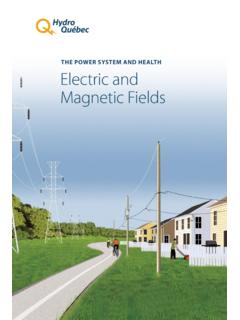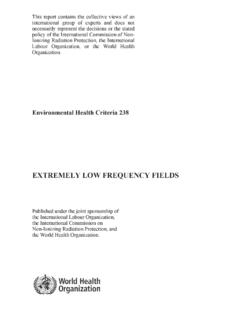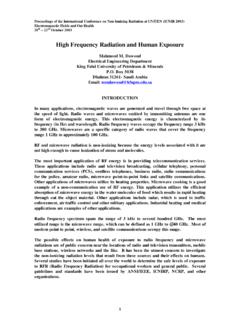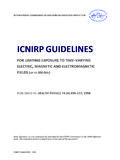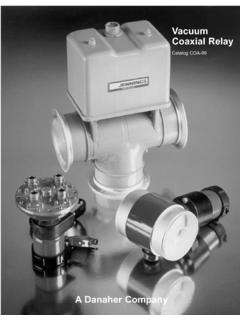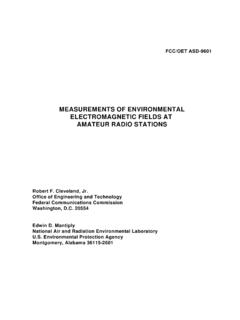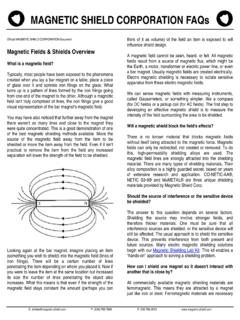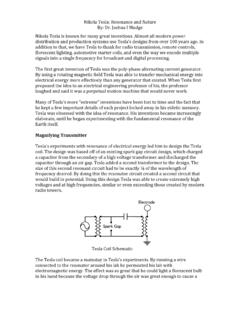Transcription of Visual display units - International Labour …
1 The International Programme for the Improvement of Working Conditions and Environment (PIACT). was launched by the International Labour Organisation in 1976 at the request of the International Labour Conference and after extensive consultations with member States. PIACT is designed to promote or support action by member States to set and attain definite objectives aiming at "making work more human". The Programme is thus concerned with improving the quality of working life in all its aspects: for example, the prevention of occupational accidents and diseases, a wider application of the principles of ergonomics, the arrangement of working time, the improvement of the content and organisation of work and of conditions of work in general, a greater concern for the human element in the transfer of technology.
2 To achieve these aims, PIACT makes use of and co-ordinates the traditional means of ILO. action, including: the preparation and revision of International Labour standards;. operational activities, including the dispatch of multidisciplinary teams to assist member States on request;. tripartite meetings between representatives of governments, employers and workers, including industrial committees to study the problems facing major industries, regional meetings and meetings of experts;. action-oriented studies and research; and clearing-house activities, especially through the International Occupational Safety and Health Information Centre (CIS) and the Clearing-house for the Dissemination of Information on Conditions of Work. This publication is the outcome of a PIACT project. Visual display units : Radiation protection guidance OCCUPATIONAL SAFETY AND HEALTH SERIES No.
3 70. Visual display units : RADIATION PROTECTION. GUIDANCE. Prepared by the International Non-Ionizing Radiation Committee of the International Radiation Protection Association in collaboration with the International Labour Organization International Labour OFFICE, GENEVA. Copyright International Labour Organization 1994. First published 1994. Publications of the International Labour Office enjoy copyright under Protocol 2 of the Universal Copyright Convention. Nevertheless, short excerpts from them may be reproduced without authorization, on condition that the source is indicated. For rights of reproduction or translation, application should be made to the Publications Branch (Rights and Permissions), International Labour Office, CH-1211. Geneva 22, Switzerland. The International Labour Office welcomes such applications.
4 ILO/ International Radiation Protection Association/ International Non-Ionizing Radiation Committee Visual display units Radiation protection guidance Geneva, International Labour Office, 1994 (Occupational Safety and Health Series, No. 70). /Guide/, /Radiation/, /Radiation protection/, /Occupational safety/, /Occupational health/, / Visual display unit /. ISBN 92-2-108262-8. ISSN 0078-3129. ILO Cataloguing in Publication Data The designations employed in ILO publications, which are in conformity with United Nations practice, and the presentation of material therein do not imply the expression of any opinion whatsoever on the part of the International Labour Office concerning the legal status of any country, area or territory or of its authorities, or concerning the delimitation of its frontiers. The responsibility for opinions expressed in signed articles, studies and other contributions rests solely with their authors, and publication does not constitute an endorsement by the International Labour Office of the opinions expressed in them.
5 Reference to names of firms and commercial products and processes does not imply their endorsement by the International Labour Office, and any failure to mention a particular firm, commercial product or process is not a sign of disapproval. ILO publications can be obtained through major booksellers or ILO local offices in many countries, or direct from ILO Publications, International Labour Office, CH-1211 Geneva 22, Switzerland. A. catalogue or list of new publications will be sent free of charge from the above address. Printed by the International Labour Office, Geneva, Switzerland Preface This publication is one of a series of practical guides on occupational hazards arising from non-ionizing radiation (NIR), carried out in collaboration with the International Non-Ionizing Radiation Committee (INIRC)1 of the International Radiation Protection Association (IRPA) as part of the ILO International Programme for the Improvement of Working Conditions and Environment (PIACT).
6 The purpose of this book is to provide information, basic reference materials and guidance regarding the safety of Visual display units (VDUs) with respect to radiation emissions. It is intended for the use of competent authorities, employers and workers, and in general of all persons in charge of occupational safety and health. The following topics are covered: characteristics, measurement and levels of radiation emissions from VDUs; assessment of exposure and laboratory studies; health effects and human studies;. prevention and control measures; and quality control and maintenance. The manuscript was prepared by an IRPA/INIRC working group, chaired by Professor B. Knave, which included Dr. M. Repacholi, Dr. J. Stolwijk and Dr. M. Stuchly from the INIRC, and Dr. U. Bergqvist from the National Institute of Occupational Health of Sweden.
7 Following comments received from INIRC members, it was reviewed in detail during the annual meeting of the IRPA/INIRC in Rome, May 1991, in cooperation with Dr. Copp e representing the International Labour Office. This book is the result of a joint ILO/IRPA-INIRC activity and is published by the ILO on behalf of the two organizations. The ILO wishes to thank the International Non-Ionizing Radiation Committee of the IRPA, and in particular Professor B. Knave and his working group for their contribution and cooperation in the preparation of this practical guide on radiation protection aspects of VDUs in the workplace. 1. Since May 1992 the INIRC of the IRPA has become an independent scientific body called the International Commission on Non-Ionizing Radiation Protection (ICNIRP) and has responsibility for NIR.
8 Protection in the same way as the International Commission on Radiological Protection (ICRP) has for ionizing radiation. (ICNIRP Secretariat: c/o R. Matthes, Bundesamt f r Strahlenschutz, Institut f r Strahlenhygiene, Ingoldst dter Landstrasse 1, D-85764 Oberschleissheim, Germany. Tel.: 49 89. 31603237; Fax: 49 89 31603111.). V. Contents Summary ..1. 1. Scope and 2. The principles of VDU construction ..7. 3. Types, sources, measurements and levels of electromagnetic fields from VDUs ..9. Ionizing (X-ray) Optical radiation ..11. Radiofrequency fields ..14. Very low and extremely low frequency Electrostatic 4. Assessment of exposure and laboratory studies ..23. Optical radiations (UVR, light and IR)..23. RF Low-frequency Static electric fields and air ions ..25. 6. Health effects and human studies.
9 27. Adverse pregnancy Ocular Effects on the 7. The organization of prevention and control measures ..33. Risk assessment ..33. Quality control, maintenance and in-service Control measures for the improvement of working conditions and the working environment ..38. 1. Alleged radiation risks from VDUs - A statement by the IRPA/INIRC ..43. 2. Some questions and answers ..45. Figures 1. The major components of the monitor in a conventional 2. The electromagnetic spectrum of radiations and Tables 1. IRPA/INIRC general public (GP) and occupational (Occ) non-ionizing radiation (NIR) limits versus levels of NIR measured from 2. Epidemiological studies comparing occurrences of spontaneous abortion and malformation for women using VDUs during pregnancy with women who did not .. 29. VII. Summary The Visual display unit (VDU) has become a major element in the modern work environment as an interface between operator and computer.
10 The discussion as to whether work at VDUs can affect human health has been centred on different types of effect such as eye changes or discomfort, musculoskeletal problems, adverse reproductive outcomes, skin disorders and stress reactions. Ergonomic and organizational concerns pertaining to eye discomfort, stress reactions or pain in the neck or the wrists and other musculoskeletal disorders, motivate a number of preventive or remedial actions. Such actions should be directed towards the VDU entity, the workplace, the work environment, the design of the work task and work organization. A large number of national and International provisions, studies, documents and recommendations have been A number of careful studies have measured the electromagnetic radiation or fields from different types of VDUs.










